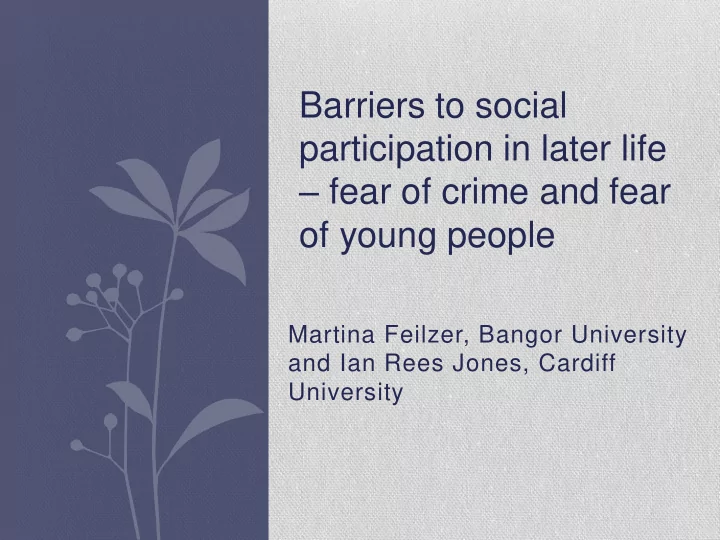

Barriers to social participation in later life – fear of crime and fear of young people Martina Feilzer, Bangor University and Ian Rees Jones, Cardiff University
Planned research • Investigate the impact of ageing on social participation through the lens of crime • Analyses of cross-sectional data over a ‘long’ period (1984 to date) of time plus analyses of datasets with reference to place, deprivation, health, and other socio- demographic factor may lead to new insights • Potentially, analyses of other datasets available – e.g. ELSA (English Longitudinal Study of Ageing); European Social Survey 2008, included a special module on ageing
Feedback cycle • Built-in feedback cycle for the research, which will start in 2017 • Presenting preliminary findings to relevant audiences to ensure that findings ‘make sense’ and resonate • Relate statistical evidence to narratives that provide context to allow effective communication
Background Some academic and policy literature on ageing and crime suggest: • Fear of crime is a serious problem for the elderly (for a summary, see Ziegler & Mitchell, 2003) • Intergenerational relationships are deteriorating causing an increase in stereotyping of young people and an increase in fear of crime among older people (Moore & Statham, 2006) BUT significant progress in ageing research and research on fear of crime
Policy examples • CPS Policy for Prosecuting Crimes against Older People – defined as 60+; specific reference is made to ‘the right to live free from the fear of crime’ • Specific community safety strategies for older people in Northern Ireland targeted at reducing fear of crime; Ireland – policing strategy to increase trust and confidence by lessening the fear of crime • Opportunity Age Strategy (2005) – tackling fear of crime; Ageing Well programme (2010-2012) – intergenerational programmes
Understanding ageing better • Increasingly, experiences of ageing are accepted as heterogeneous • The life course has become less standardised • Our understanding of the ageing process and the different stages of ageing have become more sophisticated and nuanced • Key models of ageing – lifespan model and bio- medical model – and the notion of ageing as a process of decline leading to withdrawal from society; isolation; loneliness; ill-health; and poverty are being questioned
Evidence on fear of crime • Fear of crime paradox – women and older people are more fearful of crime but less at risk of victimisation (e.g. Gilchrist, 1998, et al.) • Distinction between anxiety about crime (more widespread) and everyday worry about crime (relatively rare) – anxiety may be linked to ‘lay diagnoses about neighbourhood breakdown and stability ’ ( Farrall, 2007, 23) • Distinction between ‘feelings of safety’ and assessments of actual ‘risk of victimisation’
Evidence of link between fear of crime and ageing? • Ferraro & LaGrange, 1992, 241- 242: “older people are not more likely than younger people to be afraid of crime” – “growing older does not” … “increase the likelihood of fear of crime” • Moore, 2010, 22: “The fear of crime paradox… has been based on an over-simplistic analysis of the relationship of crime and age”
Exploratory secondary analyses • Analyses of a selection of key variables by age across three sets of British Crime Survey (now Crime Survey for England and Wales) data • Reconfiguration of data to explore cohort effects – the British Crime Survey is not a longitudinal but a cross-sectional survey
Percentage ‘feeling unsafe walking in neighbourhood after dark’ by BCS year and banded age 100.0% 90.0% 80.0% 70.0% 60.0% 1984 50.0% 1994 40.0% 2010 30.0% 20.0% 10.0% 0.0%
In contrast… •Responses to questions asking about people’s views as to the likelihood of experiencing personal victimisation suggest a decline in perceived likelihood of personal victimisation by age Additionally, • there is a significant difference in levels of anxiety (feeling unsafe walking in neighbourhood after dark) between men and women across all ages
Percentage 'teenagers are a big problem' by BCS year and age 45.0% 40.0% 35.0% 30.0% 25.0% 1994 20.0% 2010 15.0% 10.0% 5.0% 0.0%
45 Percentage ‘feeling unsafe walking in neighbourhood after dark’ by birth cohort and BCS year 40 60-64 25-29 30-34 75-79 55-59 35 35-39 70-74 50-54 40-44 45-49 30 30-34 45-49 50-54 65-69 25-29 Percentage 20-24 35-39 60-64 25 40-44 1984 55-59 1994 50-54 16-19 20 40-44 45-49 2010/11 15 10 5 0 1934-1938 1939-1943 1944-1948 1949-1953 1954-1958 1959-1963 1964-1968 1969-1973
Preliminary analyses • Clear indication in the data that by lumping people together as ‘older’, and dependent on where the cut-off is, significant differences in perceptions of safety are hidden from view • Distinct differences between levels of anxiety expressed by year of measure – time of measure may have a bigger impact on levels of anxiety than age • Even simple analyses question the perceived age – fear of crime/fear of young people link
Discussion • Ageing and increases in fear of crime or ‘fear’ of young people do not seem to be intrinsically linked – links are dependent on the measure used • Need for a more systematic understanding how different socio-economic factors, especially, place, health, deprivation, affect intergenerational contact and conflict, as well as fear of crime • Need for an increased understanding of whether crime patterns (based on BCS/CSEW data) affect levels of anxiety among the population and are possibly felt among some groups more than others
Your thoughts and comments on any aspects of the research are greatly appreciated!
References • Farrall, S. (2007). Experience and Expression in the Fear of Crime . ESRC End of Award Report. RES-000-23-1108. • Moore, S. & Statham, E. (2006). Can Intergenerational Practice offer a way of limiting anti-social behaviour and fear of crime? Howard Journal , Vol 54(5), 468-484. • Moore, S. (2010). Older people, fear and crime: problems and new directions. Working with Older People , Vol 14(4), 16-24. • Ziegler, R. & Mitchell, D.B. (2003). Aging and Fear of Crime: An Experimental Approach to an Apparent Paradox. Experimental Aging Research , Vol 29(2), 173-187
Recommend
More recommend